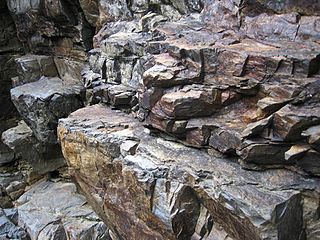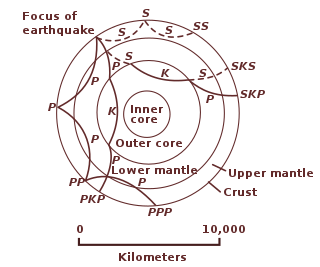Related Research Articles

Geophysics is a subject of natural science concerned with the physical processes and physical properties of the Earth and its surrounding space environment, and the use of quantitative methods for their analysis. Geophysicists, who usually study geophysics, physics, or one of the earth sciences at the graduate level, complete investigations across a wide range of scientific disciplines. The term geophysics classically refers to solid earth applications: Earth's shape; its gravitational, magnetic fields, and electromagnetic fields ; its internal structure and composition; its dynamics and their surface expression in plate tectonics, the generation of magmas, volcanism and rock formation. However, modern geophysics organizations and pure scientists use a broader definition that includes the water cycle including snow and ice; fluid dynamics of the oceans and the atmosphere; electricity and magnetism in the ionosphere and magnetosphere and solar-terrestrial physics; and analogous problems associated with the Moon and other planets.

The South Atlantic Anomaly (SAA) is an area where Earth's inner Van Allen radiation belt comes closest to Earth's surface, dipping down to an altitude of 200 kilometres (120 mi). This leads to an increased flux of energetic particles in this region and exposes orbiting satellites to higher-than-usual levels of ionizing radiation.
Localization or localisation may refer to:

Earth's magnetic field, also known as the geomagnetic field, is the magnetic field that extends from Earth's interior out into space, where it interacts with the solar wind, a stream of charged particles emanating from the Sun. The magnetic field is generated by electric currents due to the motion of convection currents of a mixture of molten iron and nickel in Earth's outer core: these convection currents are caused by heat escaping from the core, a natural process called a geodynamo.

A geomagnetic storm, also known as a magnetic storm, is temporary disturbance of the Earth's magnetosphere caused by a solar wind shock wave.

Motion capture is the process of recording the movement of objects or people. It is used in military, entertainment, sports, medical applications, and for validation of computer vision and robots. In filmmaking and video game development, it refers to recording actions of human actors and using that information to animate digital character models in 2D or 3D computer animation. When it includes face and fingers or captures subtle expressions, it is often referred to as performance capture. In many fields, motion capture is sometimes called motion tracking, but in filmmaking and games, motion tracking usually refers more to match moving.
Robotic mapping is a discipline related to computer vision and cartography. The goal for an autonomous robot is to be able to construct a map or floor plan and to localize itself and its recharging bases or beacons in it. Robotic mapping is that branch which deals with the study and application of ability to localize itself in a map / plan and sometimes to construct the map or floor plan by the autonomous robot.

Swarm robotics is an approach to the coordination of multiple robots as a system which consist of large numbers of mostly simple physical robots. ″In a robot swarm, the collective behavior of the robots results from local interactions between the robots and between the robots and the environment in which they act.″ It is supposed that a desired collective behavior emerges from the interactions between the robots and interactions of robots with the environment. This approach emerged on the field of artificial swarm intelligence, as well as the biological studies of insects, ants and other fields in nature, where swarm behaviour occurs.
A geomagnetic reversal is a change in a planet's magnetic field such that the positions of magnetic north and magnetic south are interchanged. The Earth's field has alternated between periods of normal polarity, in which the predominant direction of the field was the same as the present direction, and reverse polarity, in which it was the opposite. These periods are called chrons.
A positioning system is a system for determining the position of an object in space. One of the most well-known and commonly used positioning systems is the Global Positioning System (GPS).

An indoor positioning system (IPS) is a network of devices used to locate people or objects where GPS and other satellite technologies lack precision or fail entirely, such as inside multistory buildings, airports, alleys, parking garages, and underground locations.

In geophysics, a magnetic anomaly is a local variation in the Earth's magnetic field resulting from variations in the chemistry or magnetism of the rocks. Mapping of variation over an area is valuable in detecting structures obscured by overlying material. The magnetic variation in successive bands of ocean floor parallel with mid-ocean ridges was important evidence for seafloor spreading, a concept central to the theory of plate tectonics.
Wi-Fi positioning system is a geolocation system that uses the characteristics of nearby Wi‑Fi access point to discover where a device is located.

The Vine–Matthews–Morley hypothesis, also known as the Morley–Vine–Matthews hypothesis, was the first key scientific test of the seafloor spreading theory of continental drift and plate tectonics. Its key impact was that it allowed the rates of plate motions at mid-ocean ridges to be computed. It states that the Earth's oceanic crust acts as a recorder of reversals in the geomagnetic field direction as seafloor spreading takes place.

Earth science or geoscience includes all fields of natural science related to the planet Earth. This is a branch of science dealing with the physical, chemical, and biological complex constitutions and synergistic linkages of Earth's four spheres: the biosphere, hydrosphere/cryosphere, atmosphere, and geosphere. Earth science can be considered to be a branch of planetary science, but with a much older history.
A cover meter is an instrument to locate rebars and measure the exact concrete cover. Rebar detectors are less sophisticated devices that can only locate metallic objects below the surface. Due to the cost-effective design, the pulse-induction method is one of the most commonly used solutions.

The north magnetic pole, also known as the magnetic north pole, is a point on the surface of Earth's Northern Hemisphere at which the planet's magnetic field points vertically downward. There is only one location where this occurs, near the geographic north pole. The geomagnetic north pole is the northern antipodal pole of an ideal dipole model of the Earth's magnetic field, which is the most closely fitting model of Earth's actual magnetic field.

The south magnetic pole, also known as the magnetic south pole, is the point on Earth's Southern Hemisphere where the geomagnetic field lines are directed perpendicular to the nominal surface. The Geomagnetic South Pole, a related point, is the south pole of an ideal dipole model of the Earth's magnetic field that most closely fits the Earth's actual magnetic field.

The following outline is provided as an overview of and topical guide to geophysics:

Space climate is the long-term variation in solar activity within the heliosphere, including the solar wind, the Interplanetary magnetic field (IMF), and their effects in the near-Earth environment, including the magnetosphere of Earth and the ionosphere, the upper and lower atmosphere, climate, and other related systems. The scientific study of space climate is an interdisciplinary field of space physics, solar physics, heliophysics, and geophysics. It is thus conceptually related to terrestrial climatology, and its effects on the atmosphere of Earth are considered in climate science.
References
- ↑ US 3789351,Feldman, David W.&Slone, James C.,"Guidance system",published 1974-01-29, assigned to United States Secretary of the Navy
- ↑ Suksakulchai, S.; Thongchai, S.; Wilkes, D. M.; Kawamura, K. (October 2000). "Mobile robot localization using an electronic compass for corridor environment". SMC 2000 Conference Proceedings. 2000 IEEE International Conference on Systems, Man and Cybernetics. 'Cybernetics Evolving to Systems, Humans, Organizations, and their Complex Interactions' (Cat. No.00CH37166). Vol. 5. pp. 3354–3359 vol.5. doi:10.1109/ICSMC.2000.886523. ISBN 0-7803-6583-6. S2CID 14204871.
- ↑ Aboshosha, Ashraf; Zell, Andreas; Tübingen, Universität (2004). "Disambiguating Robot Positioning Using Laser and Geomagnetic Signatures". In: Proceedings of IAS-8. CiteSeerX 10.1.1.2.6715 .
- ↑ Haverinen, Janne; Kemppainen, Anssi (31 October 2009). "Global indoor self-localization based on the ambient magnetic field". Robotics and Autonomous Systems. 57 (10): 1028–1035. doi:10.1016/j.robot.2009.07.018.
- ↑ Miller, Dan. "Analysis & Expertise in Conversational Commerce". Opus Research. Retrieved 2014-08-02.
- ↑ redazione (2018-09-05). "Indoor localization and navigation company home page". GiPStech. Retrieved 2020-10-23.
- ↑ "Homepage of Janne Haverinen". Department of Computer Science and Engineering. University of Oulu. Archived from the original on 2014-02-26. Retrieved 2014-08-02.
- ↑ Truong, Alice (2013-09-25). "IndoorAtlas Hopes to Unlock the "Holy Grail of Advertising" With Magnetic-Field Mapping". Business + Innovation. Fast Company. Retrieved 2014-08-02.
- ↑ Clark, Liat (9 July 2012). "Finnish startup can locate you indoors using magnetic field anomalies". Wired UK . Retrieved 2014-08-02.